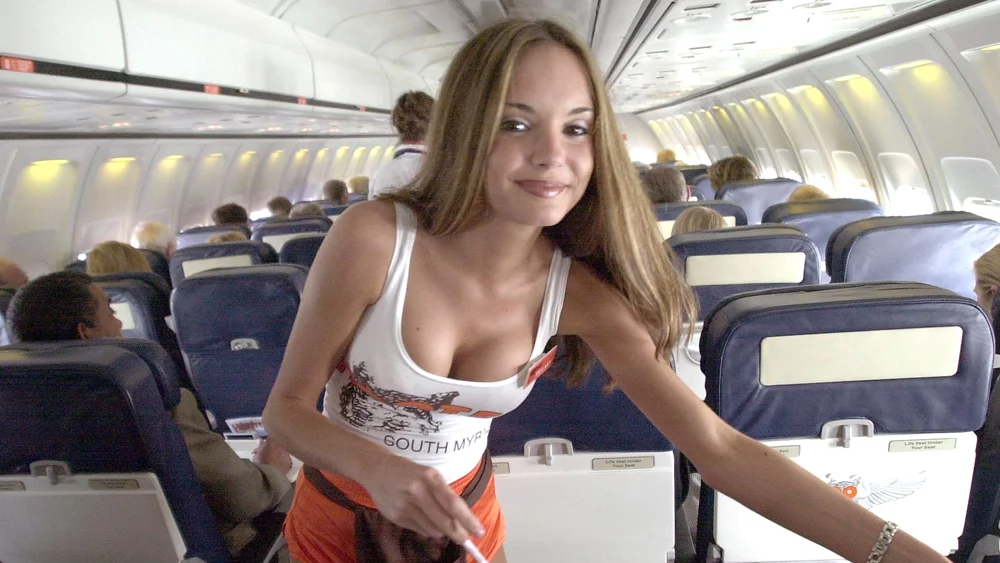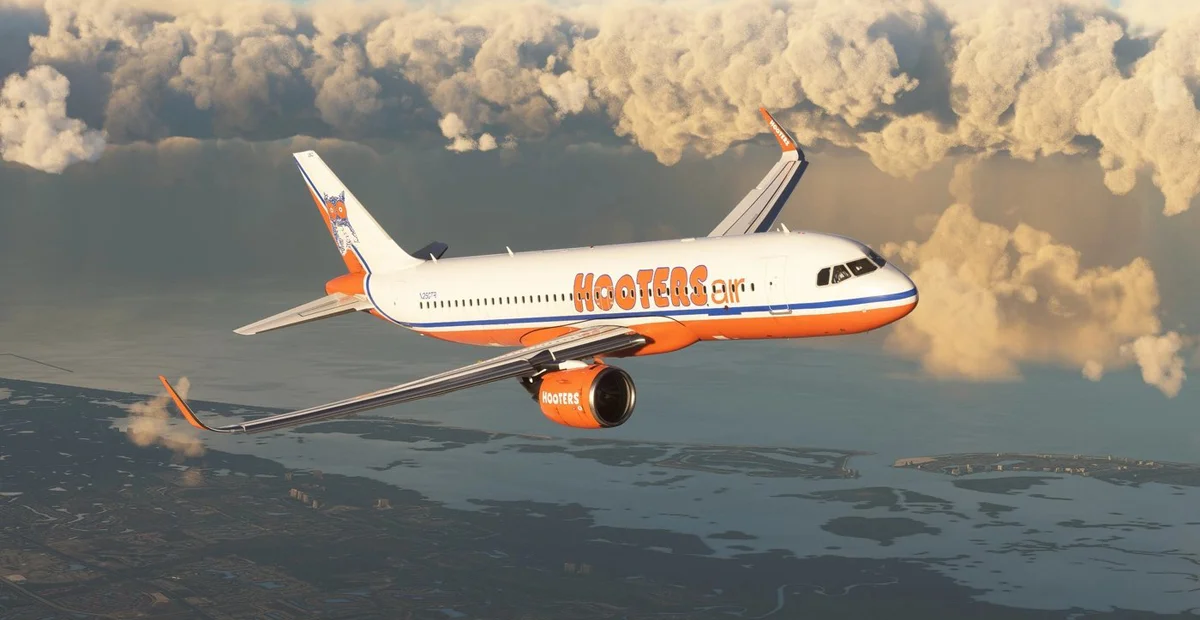In the annals of aviation history, few airlines have captured the public imagination quite like Hooters Air. More than just a transportation service, it was an audacious extension of a popular restaurant brand, promising a unique in-flight experience that defied the conventional wisdom of the early 2000s airline industry. Though its journey was short-lived, Hooters Air carved out a memorable niche, leaving behind a legacy that continues to be discussed in aviation circles today.
From Chicken Wings to Winged Journeys: The History of Hooters Air
The story of Hooters Air begins not in an airport hangar, but in the boardrooms of Hooters of America, Inc., the restaurant chain famous for its casual dining, chicken wings, and “Hooters Girls.” Robert Brooks, the owner of Hooters of America, was the visionary behind this unusual venture. In December 2002, Brooks acquired Pace Airlines, a charter airline based in Winston-Salem, North Carolina. This acquisition provided the operational backbone for his ambitious plan: to create an airline that would not only be a profitable enterprise but also a “flying billboard” for the Hooters brand.
Hooters Air officially commenced operations on March 6, 2003, with its headquarters established in Myrtle Beach, South Carolina. The choice of Myrtle Beach was strategic; the city is a popular golf destination, and Hooters Air aimed to specifically target golfers looking for a comfortable and distinctive way to travel to the area’s numerous championship courses.
The airline’s unique selling proposition was immediately apparent. While Pace Airlines pilots and traditional flight attendants handled standard flight operations, each Hooters Air flight also featured two “Hooters Girls.” Dressed in their iconic restaurant uniforms, these Hooters Girls were not involved in safety duties but focused on hospitality tasks, engaging with passengers, assisting with in-flight games and trivia, and adding a distinctive flair to the journey. This blend of traditional airline service with the Hooters brand experience was designed to differentiate it in a competitive market.
Beyond the unique cabin crew, Hooters Air also sought to distinguish itself through passenger comfort. At a time when many airlines were reducing legroom to squeeze in more seats, Hooters Air removed rows of seats from its aircraft to provide a generous 34-inch seat pitch for all passengers – comparable to, or even exceeding, the legroom offered in business class on many other carriers. All seats were upholstered in dark blue or black leather, and complimentary meals were served on flights lasting over an hour, a rarity for many low-cost carriers of the era. The aircraft themselves were painted in Hooters’ signature orange and white colors, featuring the company logo and mascot, “Hootie the Owl,” prominently on the vertical stabilizer.
The airline’s launch generated considerable media buzz, and initially, flights were often full. However, the aviation industry is notoriously challenging, and Hooters Air faced significant headwinds. The lingering impact of the 9/11 attacks on air travel demand, coupled with increasing competition from established low-cost carriers like Southwest Airlines and a sharp rise in fuel prices (exacerbated by Hurricanes Katrina and Rita in 2005), put immense pressure on the airline’s financial viability.
Hooters Air suspended all scheduled services on January 9, 2006, citing rising costs. While charter flights continued for a few more months, the airline ultimately ceased all operations on April 17, 2006. It’s estimated that the venture cost Hooters of America approximately $40 million. Robert Brooks, the founder, passed away the same year. Despite its financial outcome, Hooters Air remains a fascinating case study in airline branding and a memorable chapter in aviation history.

Hooters Air Stats and Quick Facts: A Glimpse into a Unique Operation
Hooters Air might have been a short-lived venture, but its operational characteristics and unique approach left some interesting statistics:
- Established: March 6, 2003
- Ceased Operations (Scheduled Flights): January 9, 2006
- Ceased All Operations: April 17, 2006
- Founder: Robert Brooks, owner of Hooters of America, Inc.
- Operating Certificate: Flights were operated by Pace Airlines, which Brooks had acquired. Pace Airlines held the FAA Part 121 certificate.
- Headquarters: Myrtle Beach, South Carolina, United States. Operational control and maintenance remained largely based with Pace Airlines in Winston-Salem, North Carolina.
- Estimated Loss: The venture reportedly cost Hooters of America approximately $40 million.
Fleet Information:
Hooters Air operated an all-Boeing fleet, which consisted of aircraft that were part of the Pace Airlines fleet and painted in Hooters’ distinctive livery.
- Boeing 737-200: Two aircraft.
- Boeing 737-300/400: Four aircraft (sources vary slightly on the exact -300 vs. -400 breakdown, with some mentioning 737-3G7 and 737-306 variants, and others specifying four 737-400s). These were the workhorses for shorter routes.
- Boeing 757-200: A single aircraft, used for longer-haul routes.
The interiors of these aircraft were notable for their generous legroom, with a 34-inch seat pitch for all passengers, promoting a “Club Class” feel.
Passenger Statistics:
While exact comprehensive passenger numbers for its entire operational period are not readily available, reports from the time indicated:
- In its early years, Hooters Air experienced a surge in passenger numbers due to its novelty and extensive media attention.
- At its peak, Hooters Air was reportedly flying between 3,000 and 5,000 passengers per week into the Myrtle Beach area alone.
- Early flights were often reported to be “packed with 132 passengers,” highlighting initial strong demand. However, this demand reportedly dwindled over time as the novelty wore off and external factors took their toll.
A Focus on Unique Facilities and In-flight Experience
Hooters Air didn’t operate its own dedicated airport terminals or exclusive facilities beyond standard gate operations. Its unique “facilities” were primarily manifested in its distinctive in-flight experience, which was its core differentiator.
On-board Experience:
- The Hooters Girls: On each flight, two Hooters Girls, dressed in their signature uniforms (orange shorts, white tank tops), were present. Their role was primarily hospitality-focused. They did not perform safety duties but engaged with passengers, played trivia games, handed out Hooters-branded merchandise, and generally provided entertainment. This was a direct extension of the restaurant’s customer service model.
- Traditional Flight Attendants: Alongside the Hooters Girls, there were conventionally dressed, FAA-certified flight attendants who handled all safety-related duties, service of food and beverages (beyond the Hooters Girls’ hospitality role), and standard cabin management.
- Spacious Seating: A key feature was the enhanced passenger comfort. By removing several rows of seats, Hooters Air offered an industry-leading 34-inch seat pitch in every row, providing significantly more legroom than most economy cabins at the time, even comparable to some airlines’ domestic first-class. All seats were upholstered in dark leather, giving a premium feel.
- Complimentary In-Flight Service: Contrary to the trend of unbundling services in the early 2000s, Hooters Air offered complimentary hot meals on flights over one hour. This was a stark contrast to many budget carriers that were already charging for basic amenities.
The entire “facility” concept was to extend the Hooters restaurant experience into the air, making the flight itself part of the leisure or vacation experience, rather than just a means of transport.
The Airline Network: Connecting Fun with Destinations
Hooters Air’s route network was primarily focused on leisure destinations, with a strong emphasis on connecting to its home base in Myrtle Beach, South Carolina. The airline aimed to provide direct, convenient, and uniquely themed flights to locations popular with its target demographic, particularly golfers and vacationers.
Key Routes and Destinations:
- Myrtle Beach, South Carolina (MYR): This was the primary hub and focus of Hooters Air. Most routes either originated from or terminated at Myrtle Beach, underscoring its role in promoting tourism to the area.
- Atlanta, Georgia (ATL): A major hub, serving as one of the initial routes from Myrtle Beach.
- Baltimore, Maryland (BWI): Provided connections to the Mid-Atlantic region.
- Columbus, Ohio (CMH): Served as a mid-western gateway.
- Fort Lauderdale, Florida (FLL): A popular Florida destination.
- Fort Myers, Florida (RSW): Another Florida beach destination.
- Gary, Indiana (GYY): Served the Chicago metropolitan area, specifically targeting travelers from the Midwest.
- Las Vegas, Nevada (LAS): A major leisure and entertainment hub, aligning with the Hooters brand. Plans were in place to connect to a new Hooters resort and casino in Las Vegas.
- Nassau, Bahamas (NAS): Offered an international, tropical escape.
- Newark, New Jersey (EWR): Provided access to the New York City metropolitan area.
- Orlando Sanford International Airport, Florida (SFB): Another Orlando-area airport popular with leisure travelers.
- Pittsburgh, Pennsylvania (PIT): A major city in the Northeast.
- Rockford, Illinois (RFD): Served the greater Chicago area, though this route was later cancelled due to competition.
- St. Petersburg/Clearwater, Florida (PIE): Another Florida Gulf Coast destination.
- Denver, Colorado (DEN): A western destination, though the route from Rockford was discontinued.
The strategy was to offer non-stop flights to these destinations, emphasizing convenience and reducing travel time for its target audience.
Ground Transportation & The Unconventional Approach
Given that Hooters Air was a relatively small airline operating out of existing commercial airports, it did not have dedicated ground transportation infrastructure beyond what was typical for any airline. Passengers arriving or departing from Hooters Air flights would utilize the standard ground transportation options available at each airport it served. This would have included:
- Airport Taxis: Standard metered taxi services.
- Shuttle Buses: Shared-ride shuttles to hotels or specific city areas.
- Rental Cars: Car rental agencies located at the airports.
- Public Transit: Where available (e.g., buses or limited rail links, depending on the specific airport).
Hooters Air’s innovation was purely in the air, not on the ground. Its business model relied on attracting customers to its in-flight experience rather than offering unique landside services. The goal was simply to get passengers to their leisure destinations, often Myrtle Beach, where the Hooters brand presence was already strong and extended to local hospitality options.
Despite its brief tenure, Hooters Air carved out a unique place in aviation history. It demonstrated an ambitious attempt at brand extension and a bold departure from traditional airline service models. While it ultimately failed to achieve sustained profitability, its story continues to fascinate and serves as a reminder of the often-unpredictable nature of the airline industry. It remains a memorable example of a “flying billboard” that truly took flight, however briefly.
Keyword: DeadAirlines

